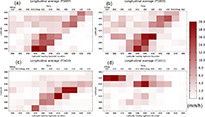** Progress in Earth and Planetary Science is the official journal of the Japan Geoscience Union, published in collaboration with its 50 society members.
Gallery View of PEPS Articles
Research
Atmospheric and hydrospheric sciences
202008202008
Typhoon-induced precipitation characterization over northern Japan: a case study for typhoons in 2016
Nayak S, Takemi T
Precipitation characterization, Precipitation size, Precipitation duration, Typhoon, Radar-AMeDAS
The latitudinal variation of the area-averaged precipitation over the box region during the northward translation of the four typhoons in summer 2016
Longitudinally averaged precipitation at different latitudes against the position of the typhoon center for (a) Typhoon Chanthu (T1607), (b) Typhoon Mindulle (T1609), (c) Typhoon Lionrock (T1610), and (d) Typhoon Kompasu (T1611)
In August 2016, northern Japan was stuck by apparently unusual occurrence of the landfall of four typhoons and experienced record-breaking heavy precipitations. This study analyzed the extreme precipitations carried out by these four typhoons to understand their internal structure over northern Japan by computing the probability distributions of precipitation durations with their peak intensities exceeding a range of percentile thresholds starting from 70 to 99%. The main focus was on the duration and size of the extreme precipitations together with the precipitation structure over northern Japan during the passage of each of these four typhoons through different latitudinal locations. To our knowledge, this is the first study to examine the long-lasting and widespread extreme precipitations carried by individual typhoon and such information are crucial for prevention of and protection from typhoon-related hazards over Japan. We find that the typhoons landfalled over Hokkaido region exhibit similar characteristics of precipitation duration, while the typhoon landfalled over Tohoku region shows relatively long-lived precipitation durations. However, all the four typhoons show a robust feature in the precipitation sizes over northern Japan. The occurrence of heavy precipitations with intensity higher than 20–30 mm h−1 is more frequent and last 6 to 9 h over northern Japan. These features may explain the excessive precipitations caused by each typhoon. The important information contained in this study is the duration and size of the precipitations induced by the typhoons vary depending on the landfalling region. However, the precipitation characteristics associated with all the three typhoons landfalled over Hokkaido show mostly robust features. This study gives a first step towards a description of the spatio-temporal characteristics of typhoon-induced precipitations and has an overall implication towards the future research that is needed for the assessment of typhoon-induced precipitation-related disasters in future warming climate.







